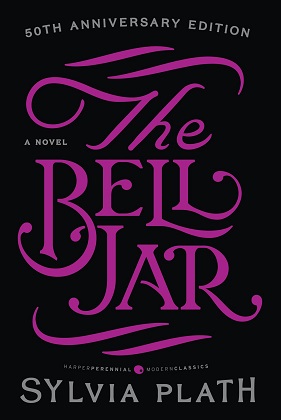
I consumed every word, every letter and it nourished me like no book had ever done. Through the eye of a needle the sentences threaded themselves. As my eyes were carefully moving down the page, greedily taking in every word imprinted on it, the needle was leaving patterns, textures and marks on my skin. Touching me quickly, stinging, finding its way through the still flesh and leaving a simplistic, yet an enchanting pattern on my skin.
A reminder of “The Bell Jar”, a classic that spoke to me.
Sylvia Plath’s novel is imbued with somber thoughts and descriptions belonging to a young student Esther Greenwood, whose scholarship, grades and internship in New York are far from what many consider to be “unsuccessful”. As suicidal thoughts start to take over, we see her neglecting the once ambitious and realistic plans one after another, and replacing them with all the ways she can end her own life. She cannot sleep, she cannot read, eating has become insufferable. The bell jar traps Esther, and we are unsure if it will crack, lift or threaten even slightly the confinement she finds herself in.
Sylvia Plath’s only novel, which is considered to be a semi-autobiographical piece, is a noteworthy addition to her other works, allowing them all to speak more clearly to the reader by creating a stunning background for her poetry. As beautiful as they are painfully earnest, the words Sylvia conveys should not be taken lightly and the readers must evaluate the effect of a work like “The Bell Jar” on their own well-being. To some, Sylvia’s words provide shelter and shed light on their own lurking pain, to others they can leave the bell jar more unswerving than it had been before.
“I saw my life branching out before me like the green fig tree in the story. From the tip of every branch, like a fat purple fig, a wonderful future beckoned and winked. One fig was a husband and a happy home and children, and another fig was a famous poet and another fig was a brilliant professor, and another fig was Ee Gee, the amazing editor, and another fig was Europe and Africa and South America, and another fig was Constantin and Socrates and Attila and a pack of other lovers with queer names and offbeat professions, and another fig was an Olympic lady crew champion, and beyond and above these figs were many more figs I couldn’t quite make out. I saw myself sitting in the crotch of this fig tree, starving to death, just because I couldn’t make up my mind which of the figs I would choose. I wanted each and every one of them, but choosing one meant losing all the rest, and, as I sat there, unable to decide, the figs began to wrinkle and go black, and, one by one, they plopped to the ground at my feet.”
***
Harper Collins, 2015
Check from the OverDrive digital library
Jana Kotsolainen
Tallinn Central Library volunteer

